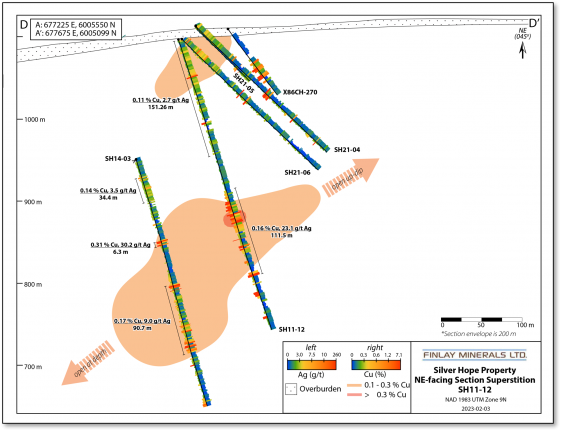Finlay’s 100%-owned Silver Hope property covers 213.11 km2 of ground surrounding the past-producing Equity Silver Mine in the prospective Skeena Arch region of central B.C.
The regional-scale northeast-trending Skeena Arch is a geologic uplift in the Stikine Terrane that hosts several mineral deposits of various types. The area surrounding the property hosts past-producing deposits including the Equity Silver and Silver Queen Au-Ag-Zn-Cu vein filling-replacement deposits and the Huckleberry, Bell – Granisle, and Endako porphyry deposits. Several companies, including Centerra Gold, Surge Copper, Equity Minerals, Sun Summit, Universal Copper, and Imperial Metals, are actively engaged in exploration in the region.
The three most advanced targets on the property: the Hope, Superstition and Gaul zones, are encompassed within the Main Horizon, which extends southward from the Equity Silver mine and hosts significant Ag and Cu mineralization in fractures, micro-fractures, veins, and massive sulphide sections. Other mineral occurrences on the property include the West Horizon Cu-Mo QMZ Porphyry, the Sam Ag+Zn bearing breccia, the East Horizon, Allin, Dina, and Goosly Lake.
Finlay continues to drive expansion of the known mineralization within the Main Horizon while developing other numerous exploration targets on the Silver Hope property.
The Silver Hope property is situated within the Skeena Arch, a regional-scale northeast-trending belt of sedimentary, volcanic, and associated plutonic rocks of the Stikine island-arc assemblage, which hosts several mineral deposits of various types in Central B.C. Silver Hope lies on the east margin of the southern Skeena Arch in an area of localized subsidence referred to as the Buck Creek Basin.
The Stikine Terrane was host to two main episodes of post-accretionary, continental margin arc magmatism: Upper Cretaceous (93 – 74 Ma) and Lower to Middle Eocene. Cretaceous intrusions in the region host the past-producing Huckleberry, Bell – Granisle, and Endako porphyry deposits.
In the Buck Creek Basin, two episodes of Paleogene volcanism are preserved: 1) Late Paleocene/ Lower Eocene Nanika Plutonic Suite; and 2) subvolcanic intrusions of the Goosly Lake Formation (52 Ma), which are believed to be responsible for the Equity Silver and Silver Queen Au-Ag-Zn-Cu vein filling-replacement deposits. The Equity Silver deposit is considered a replacement-style deposit and occurs directly adjacent to a monzodiorite stock of Goosly Lake Formation. At the Silver Queen deposit, ~30 km west of the property, Goosly intrusion-related dykes are contemporaneous with the emplacement of mesothermal and epithermal polymetallic veins.
The Silver Hope property is underlain predominantly by andesitic and basaltic volcanic rocks of the Eocene Endako Group surrounding an erosional window of uplifted Cretaceous Skeena Group stratigraphy which is bound to the west and northeast by stocks and plugs of Paleocene Nanika Suite and the Eocene Goosly Intrusive Suite, respectively.
Exposed Cretaceous Skeena Group stratigraphy strikes north‐northeast and dips moderately gently west. Younging from east to west, exposed Skeena Group consists of:
Surrounding the exposed Skeena Group stratigraphy, younger Cretaceous Kasalka Group andesite and Eocene Endako Group volcanics predominate.
At the western margin of the uplifted Cretaceous stratigraphic package, a quartz monzonite stock of the Paleocene Nanika Intrusive Suite extends for ~2 km along the strike of the sediments. This stock hosts the West Horizon porphyry Cu-Mo mineralization intersected in 2010 and 2011 drill holes.
The northeast edge of the Cretaceous stratigraphic package abuts an east-southeast trending complex of gabbro, monzogabbro, and monzonite of the Eocene Goosly Intrusive Suite. At the Main Equity Silver deposit, a plug of gabbro (48 Ma) with associated monzonite to diorite phases truncates pyroclastic flows of the Skeena Group, which hosts economic fracture-fill, disseminated, and replacement style mineralization. The margins of this intrusive complex were a target area for the 2020 and 2021 exploration programs.
Post-mineral andesite and quartz latite dykes of Eocene age (49 Ma) cut the Cretaceous and Eocene strata on both the Equity Silver and Silver Hope properties. At the Gaul/Silver Hope Zone, mineralization is often concentrated marginal to these late dykes, possibly due to remobilization or exploitation of long-lived structures, or concentration of strain and associated fluids along relatively competent tabular bodies.
The Silver Hope property hosts eight (8) known mineral occurrences, including meso-thermal ‘Equity-Style’ Ag-Cu, polymetallic vein and replacement style Cu-Ag-Au+/-Pb+/-Zn and porphyry Cu-Mo mineralization.
In addition to the advanced-stage Main Horizon, several peripheral targets are being actively explored for porphyry potential.
The Main Horizon extends southerly from the Equity Mine deposits and is a 2 km Cu-Ag-Au mineralized trend that encompasses, from north to south on the Property, the Hope, Superstition and Gaul Zones.
Hope Zone
The Hope Zone lies ~2 km along strike to the south-southwest of the Equity Main Zone near the stratigraphic contact of the sedimentary-volcanic and pyroclastic divisions of the Mount Ney Volcanics. Mineralization comprises ubiquitous fracture-filling pyrite ± quartz, calcite, chlorite, chalcopyrite and tetrahedrite which locally form sub-metre zones of dense stockwork, micro fracturing and brecciation. Higher fracture density is associated with more intense alteration, brecciated veining, and greater diversity in sulphide minerals. The highest-grade Cu-Ag mineralization occurs in a series of parallel metre-scale zones of moderately to steeply west-dipping breccia veins and dense stockworks which host semi-massive tetrahedrite ± pyrite ± chalcopyrite, sphalerite and galena. Anomalous amounts of Au, As, Sb, and locally, Bi are present. Hope Zone was drilled extensively in 1986, as well as in 2007 when all holes intersected significant mineralization including 106.0 m assaying 0.23% Cu, 43.4 g/t Ag and 0.06 g/t Au from 179.0 m in SH07-02 including 6.1 m assaying 0.65% Cu, 352.1 g/t Ag and 0.13 g/t Au from 225.5m. Subsequent drilling in 2011 intersected 119.8 m assaying 0.39% Cu, 9.2 g/t Ag and 0.02 g/t Au from 313.8 m in SH11-07.
Superstition Zone
Mineralization at the Superstition Zone, ~150 m along strike of Hope, consists of chalcopyrite, sphalerite, arsenopyrite and tetrahedrite veinlets cutting variably sericitized and silicified dust tuffs. Pyrite is ubiquitous and often accompanied by arsenopyrite, chalcopyrite, and sphalerite. Minor galena and molybdenite occur in fractures and tension gashes in localized breccias. Superstition was drilled in 1986 and several subsequent campaigns. Significant mineralization in SH11-12 assayed 0.16% Cu, 23.1 g/t Ag and 0.29 g/t Au over 111.5 m from 204.0 m including 12.9 m assaying 0.56% Cu, 47.5 g/t Ag and 0.42 g/t Au from 232.3 m.
Gaul Zone
The Gaul occurrence is similarly hosted by the Lower Cretaceous Skeena Group pyroclastic sequence, predominantly the middle division: a heterogeneous sequence of tuff, breccia and reworked pyroclastic debris. Sulphide mineralization occurs as fracture fillings, within quartz-carbonate veins, and disseminated in wall rock. Mineralization is comprised of low-grade chalcopyrite and tetrahedrite with occasional narrow sections of high-grade chalcopyrite. Sphalerite and rarely galena occur locally; pyrite is ubiquitous. Sulphide mineralized veins are typically discordant, forming angles of 60 – 80° to bedding. Chalcopyrite mineralization increases locally with tetrahedrite and occasionally sphalerite mineralization usually occurring in the thicker quartz-carbonate veining. Hole SH14-02 intersected 225.5 m of 0.14% Cu, 17.2 g/t Ag, and 0.04 g/t Au from 38.0 m including 36.7m assaying 0.42% Cu, 90.2 g/t Ag and 0.08 g/t Au from 62.6 m. Drilling at Gaul in 2020 identified high-grade Cu mineralization, with SH20-06 yielding 10.0 m of 2.33% Cu, 65.0 g/t Ag and 0.11 g/t Au from 27.0 m within a broader interval of 249.5 m assaying 0.25% Cu, 6.0 g/t Ag and 0.06 g/t Au from 27.0m. Drilling in 2021 extended mineralization to the south with SH21-09 intersecting 102.3 m assaying 0.35% Cu, 11.3 g/t Ag and 0.11 g/t Au from 54.5 m including 20.1 m assaying 1.26% Cu, 38.6 g/t Ag and 0.30 g/t Au from 135.0 m.
West Horizon Cu-Mo Porphyry
The West Horizon comprises Cu-Mo porphyry mineralization in a monzonite stock of the Paleocene Nanika Intrusive suite that traverses the western margin of the Skeena stratigraphic package. It is exposed at surface only as float and root jack. Drilling of the West Horizon in 2010 and 2011 yielded several long (~200 m) intercepts of ~0.3% Cu and 0.015 % Mo over a strike-length of ~ 1 km (Gruenwald, 2011).
Sam Occurrence
Another area for further exploration lies west of a deviation in the north end of the Cu-Mo porphyry Nanika stock, where two historic soil samples yielded up to 15.3 g/t Ag, 45 ppb Au, and 767 ppm Cu. At the Sam occurrence, ~2 km west, metre-scale massive sulphide veins and associated mineralization do not have a known intrusive source (BC Minfile 093L 260).
East Horizon
The East Horizon is underlain by dacitic tuffs, sedimentary rocks and possible volcanic flows that are thought to be prospective hosts for Cu‐Ag massive sulphide mineralization such as that at Equity (Alldrick & Lin, 2007; Fig. 5). Strata are subvertical and include massive to laminated dacitic dust, crystal, ash and lapilli tuffs, argillite with primary pyrite ± pyrrhotite, and coarse-grained heterolithic sedimentary breccia and conglomerate. Observed deformation in bedded dust tuffs ranges from open flexures (wavelength 1‐1.5 m) to very small-scale isoclinal folds and disrupted bedding. A prominent north-trending IP chargeability anomaly delineates the area and the presence of pyrite, arsenopyrite, tetrahedrite, galena, and sphalerite have been confirmed by rock sampling and drilling (Gruenwald, 2019). The single drill hole, SH11-08, yielded locally elevated As, and one occurrence of 498 g/t Ag, 0.22% Cu, and >100 ppm W over a 2.01 m gouge-bearing fault zone (388.72 – 390.73 m).
Allin
The Allin occurrence is located 4.4 km east of Equity Main in an area underlain by andesites and trachyandesite flow breccias in the basal part of the Goosly Lake Volcanics. Mapping along Allin Creek shows the presence of a small body of quartz microdiorite and some highly altered gossanous volcanics that are probably dacitic. Several geochemical and geophysical surveys were conducted over the Allin claim area during the time of the Equity Silver discovery. Drilling in 1987, within an area of coincident geochemical and geophysical anomalies, intersected moderately to strongly altered (quartz-sericite-pyrite and chlorite-calcite-pyrite) volcanic rocks with up to 15 % disseminated and fracture-controlled pyrite and pyrrhotite with minor to trace sphalerite, chalcopyrite, arsenopyrite, galena, molybdenite and tetrahedrite. Glacial till sampling in the area yielded highly anomalous base, precious metal, and pathfinder elements (Ferbey, 2011).
The 2021 field work explored several targets throughout the property but focused on the central portion of the property between the Equity East and Allin targets. Chargeability anomalies were found at both target areas, roughly coinciding with mapped intrusions and soil geochemical anomalies. Historic drill holes in the Allin target area were drilled ~1 km east of the 2021 chargeability anomaly. Attempts to follow-up on ore-grade Au-Cu float boulders from 1990 were unsuccessful, nonetheless, till geochemical anomalies south of the Allin target area remain unexplained (Ferbey, 2011). The chargeability anomalies at both Allin and Equity East are comparable in size and intensity to the 2011 chargeability anomaly that underlies and surrounds the Main Horizon. In 2022, three drill holes were completed in the Allin Zone and were dominantly Ootsa mixed volcanics with minor Goosly intrusions. Among these drill holes there is an overall transition top-to-bottom and south-to-north from illite-chlorite spectral mineralogy towards more variable assemblages involving illite-chlorite-smectite epidote-carbonate with a transition from propylitic to weak phyllic alteration at depth. Alteration analysis puts the Allin Zone in a low temperature hyrdrothermal environment and distal to a porphyry/higher temperature environment.
Goosly Lake
The Goosly Lake intrusion, 4.8 km east of Goosly Lake, is a quadrate body, approximately 3.2 km on a side, which cuts Early Mesozoic lavas and pyroclastic rocks with some argillite. The intrusion seems to be the source of trachyandesite and trachyte of the Eocene Goosly Lake volcanics.
Dina
The Dina occurrence, 350 m west of Goosly Lake, comprises pyrite, tetrahedrite and chalcopyrite disseminated in lapilli tuff and breccia as well as concentrated along steeply dipping bedding planes in argillite. A drillhole from 1970 intersected 0.22 % Cu and 20.23 g/t Ag in a sequence of dacite ash tuff and dust tuffs over 21.3 m from 39.6 to 60.9 m (Minfile 093L 313).
Equity East
The 2020 and 2021 exploration campaigns have identified the area east of the Equity Main Zone underlain by the Goosly Intrusive complex as a prospective target area. A property-wide airborne magnetic survey in 2020 delineated a regional magnetic high anomaly associated with the intrusive suite. Soil sampling identified a coincident multi-element geochemical anomaly consisting of elevated Ag, As, Cu, Mo, Pb, and Zn in addition to several pathfinder elements (Hg, Bi, Te, Se, +/- Sb and +/- Tl). Rock samples collected included gabbro and tuffs, locally strongly oxidized with moderate to strong quartz, sericite and pyrite alteration. Minor quartz veining was present in some rock sampled with pyrite, galena and chalcopyrite. The best assays for the rock samples were 2.97 g/t Ag, 50 ppb Au, 1,095 ppm Cu, 2,980 ppm Pb and 3,360 ppm Zn. The target area is also identified by a prominent 5-km-long, NNE trending airborne ZTEM geophysical anomaly, similar to the one reflecting the Main Horizon.
In 2021, ground-based IP surveys outlined a sizeable chargeability and resistivity anomaly over ~ 1 x 2 km, roughly coincident with the magnetic high, ZTEM anomaly, and multi-element geochemical anomaly. In 2022, three drill holes were completed in the Equity East Zone. All three holes intersected overlying Ootsa Volcanics followed by a Monzonite of the Goosly Intrusive Suite. SH22-01 intersected 0.81 m assaying 47.9 g/t Ag, 2.5% Pb and 4.5% Zn from 74.92 m. SH22-05 and 06 intersected minor galena and sphalerite veins within the Ootsa Volcanics. Mineralization is associated with increased Sulphur and either illite-kaolinite (Goosly) or chlorite-smectite (Ootsa) spectral mineralogies.
Various geophysical methods have been successful in identifying targets on the Silver Hope property, which is largely covered by glacial till. Since 2007, Finlay has completed 100 line-km of Induced Polarization (IP) surveys, 6 line-km of ground-based Gravity surveys, 467 km of airborne ZTEM surveys, and 1,585 km of Airborne Magnetic surveys. Successful IP campaigns have been completed over the Main, West, and East Horizons, as well as the Equity East and Allin targets in the central portion of the property. In 2013, a ZTEM survey was flown from the Main Trend and central portion to the southern edge of the property. In 2020, Finlay commissioned an Airborne Magnetic survey over nearly the entire property. The combination of these geophysical surveys with surface sampling and drilling have aided in targeting and increasing geological knowledge of the property.
The Main Horizon manifests in IP surveys as a north-south trending, west-dipping high chargeability and lower resistivity anomaly present for > 2 km along the mineralized trend. The chargeability high coincides with a high conductivity trend from the 2013 ZTEM survey, which connects northward to the Southern Tail and Main Zone of the Equity Silver Mine. Drilling of chargeability highs along the Main Trend has yielded significant Cu ± Ag ± Au mineralization within fractures, breccias, shears, and veins. Elevated sulphides including pyrite, chalcopyrite and tetrahedrite occur within the higher chargeability zones. Measurements from oriented core show that the mineralized fractures, breccias and veins often follow a similar orientation as the geophysical anomalies.
Along the West Horizon, where a Cu-Mo ± Au porphyry is exposed at surface, a series of IP surveys has outlined a plug-like high chargeability feature with coincident low resistivity consistent with the intrusive host rock. The Cu-Mo ± Au mineralization is hosted in chalcopyrite and molybdenum which occurs disseminated and within veins throughout the intrusion.
The East Horizon shows geophysical similarities to the Main Horizon. The IP surveys have shown an east-dipping moderate chargeability and low resistivity anomaly. ZTEM imagery also reveals a conductive trend subparallel to that of the Main Horizon along a portion of the East Horizon. Past drilling at the East Horizon was down-dip of the chargeability and resistivity anomalies, potentially missing any mineralized horizon similar to that of the Main Trend.
In 2021, Finlay completed 21 line-km in five survey lines over the central portion of the property; the survey successfully outlined two major high-chargeability anomalies occurring along the periphery of the magnetic high and beneath the multi-element soil geochemical anomalies underlying the Equity East and Allin target areas. A large magnetic high feature at surface above a ZTEM-derived low conductivity / high resistivity core at depth supports the presence of the Goosly Plutonic Suite beneath the central portion of the property. Several chargeability and resistivity IP anomalies occur at the periphery of the larger geophysical feature. Given that the Goosly Plutonic Suite is a likely source of mineralization for the Main Trend (Newmont’s Equity Silver Mine Main & Southern Tail deposits, and Finlay’s Superstition, Hope and Gaul Zones), the Company considers the Equity East and Allin geophysical and geochemical anomalies at the periphery of the intrusions to be high priority for porphyry exploration on the property.
2020 Airborne Magnetics (TMI) Geophysical Survey of the Silver Hope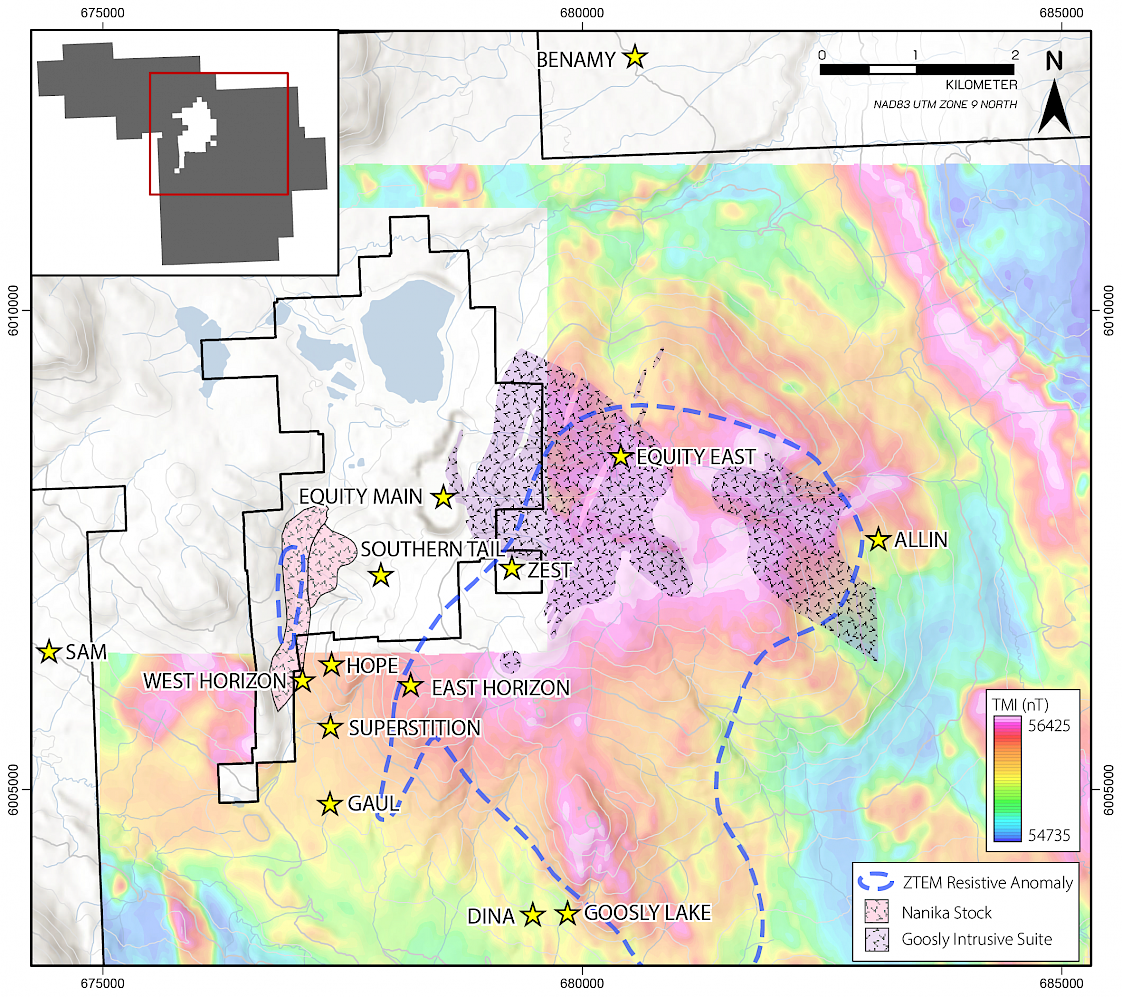
2020 Airborne Magnetics with 2021 IP Geophysical Survey Lines
2021 Line 5900N IP Resistivity and Chargeability Sections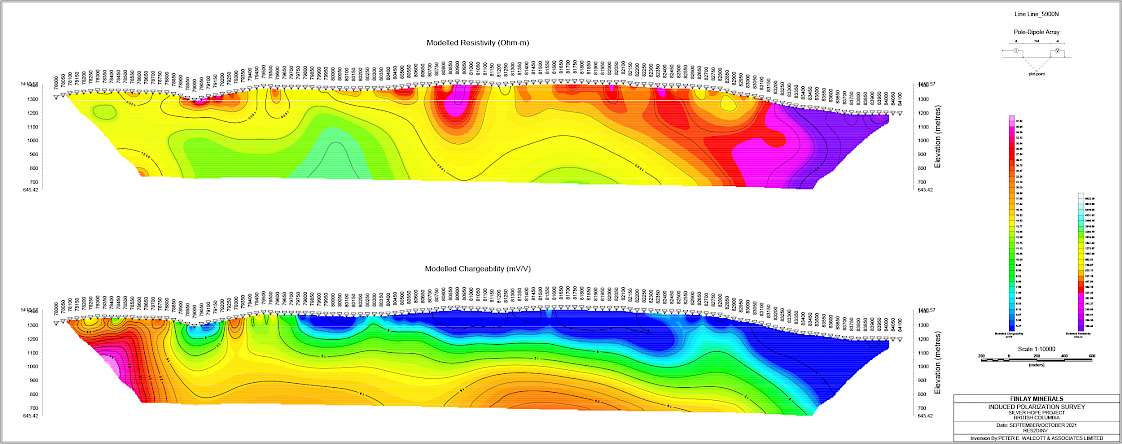
2021 Line 6900N IP Resistivity and Chargeability Sections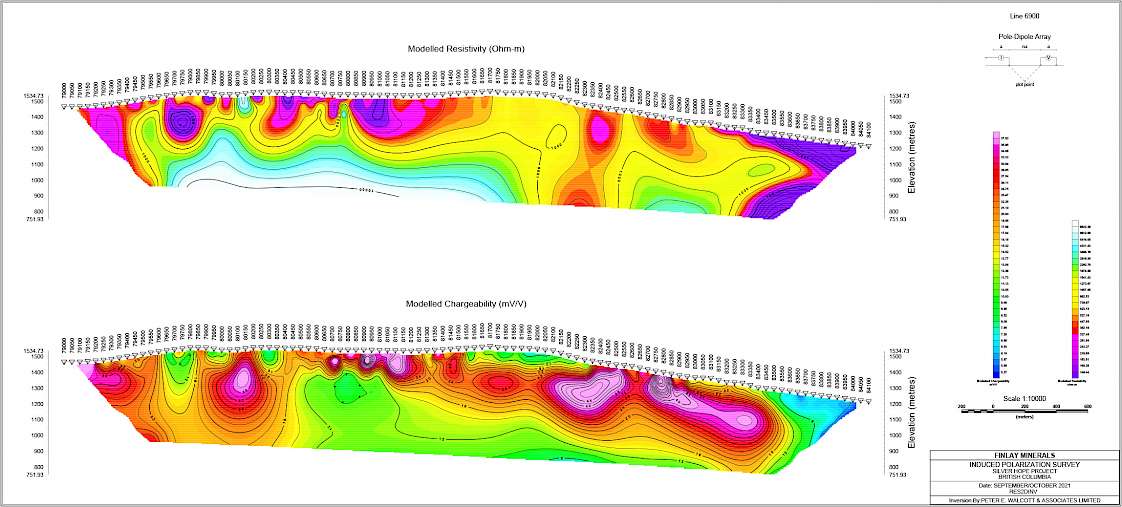
2021 Line 7400N IP Resistivity and Chargeability Sections
Since 2007, Finlay Minerals has drilled 14,341 m in 42 drill holes in the Main, West, and East Horizons. Previously, drilling had tested the Main Horizon, Allin Zone, Dina and the area east of the Sam showing. Most of the drilling completed by Finlay has targeted the low-sulphidation Cu-Ag ± Au mineralization along the Main Horizon south of the Equity Main Zone. Drilling has delineated the Hope, Superstition and Gaul Zones, which together comprise a west-dipping mineralized trend that extends for 2 km along strike.
Finlay has recently focused most of the drilling on the Gaul Zone which remains open at depth and to the south. The Gaul Zone coincides with a chargeability high and NNE-trending conductive trend. Finlay has completed 11 drill holes for 2,282 m within the Gaul Zone. Before 2007, drilling was completed at the Gaul Zone, but some drill hole assays are missing and note recorded in public documents. Mineralization at Gaul has been intersected over 500 m of strike and almost 200 m vertical depth.
Finlay has drilled 1,973 m in six drill holes within the Superstition Zone. The 2011 drill program intersected mineralization deeper than that of the Gaul and Hope Zones. Past drilling did not drill deep enough to test the west-dipping mineralized trend. Further drilling is needed to test the continuity of the mineralization along-strike towards Gaul and at depth.
The Hope Zone has been drill tested with 11 drill holes for 4,291 m. Mineralization is similar to the Gaul and Superstition Zones but the mineralization is hosted within narrower breccia zones and stockwork veins. Deeper drilling has intersected thicker higher-grade mineralization similar to the Gaul and Superstition Zones and requires further drill testing. Drilling has extended the mineralization over 250 m of strike and to a vertical depth of just over 400 m.
Between 2010 and 2011, Finlay drilled 9 drill holes for 3,773 m within the Cu+Mo+Au porphyry mineralization of the West Horizon. The drilling extended mineralization to 1 km along strike and to a vertical depth of 350 m. The West Horizon Cu+Mo+Au porphyry remains open to the west.
The 2022 drill program included three drill holes in Equity East and three drill holes in the Allin Zone for a total of 1,461 m. Drilling targeted IP and multi-element surface geochemical anomalies. Drilling identified propyltic to weakly altered Ootsa volcanics within the Allin Zone peripheral to a possible prophyry/higher temperature source. Drilling within the Equity East intersected Ootsa Volcanics overlying Monzonite of the Goosly Intrusive Suite. Further investigation is warranted based on anomalous assays and alteration.
Gaul Zone Assay Table
Superstition Zone Assay Table
Hope Zone Assay Table
West Horizon Zone Assay Table
Sam Zone Assay Table
2020 Airborne Magnetics Survey of the Silver Hope with Historic Drill Holes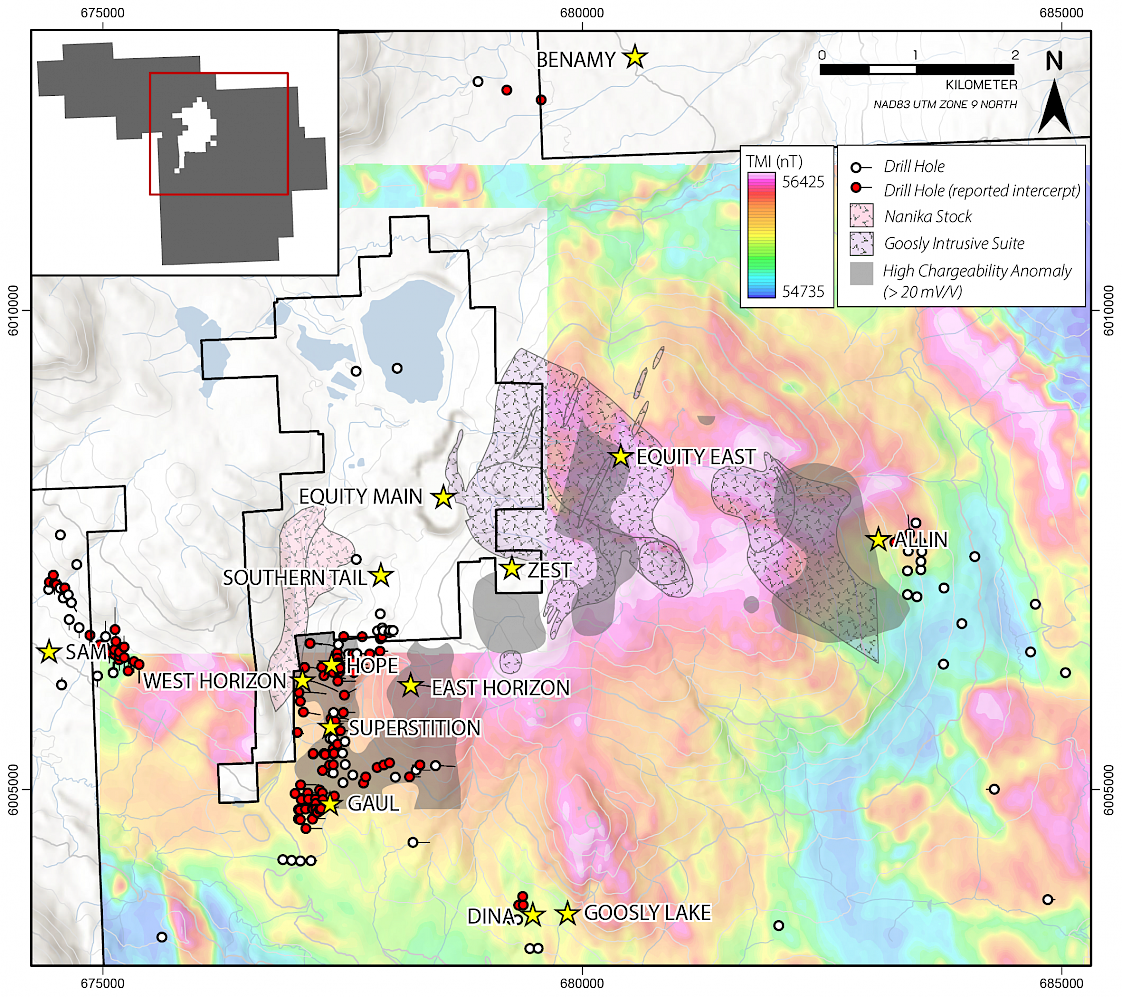
Silver Hope Main Trend with Modelled Mineralization and Historic Drill Holes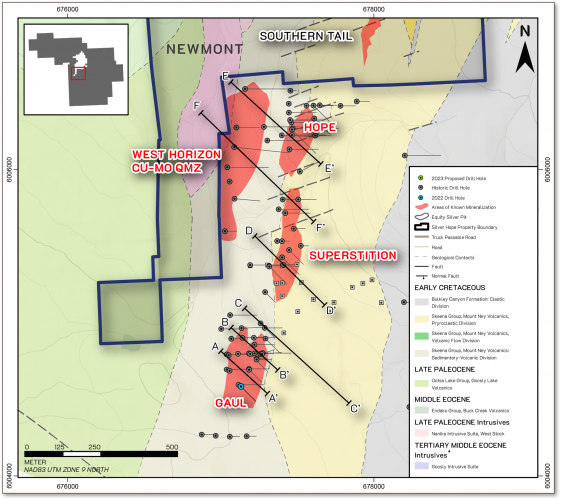
Main Trend Gaul Zone Section A-A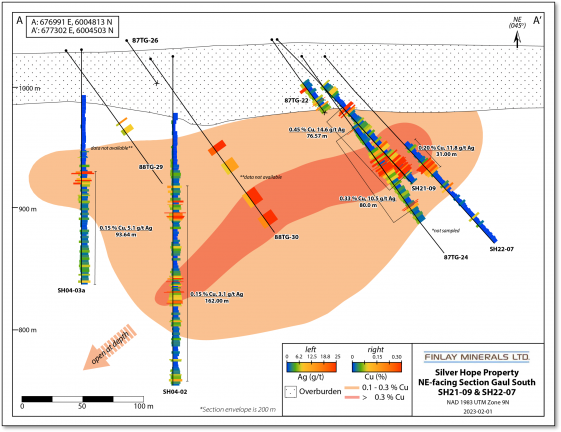
Main Trend Gaul Zone Section B-B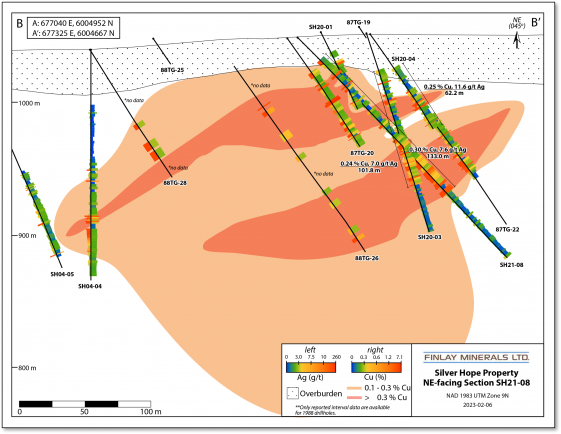
Main Trend Gaul Zone Section C-C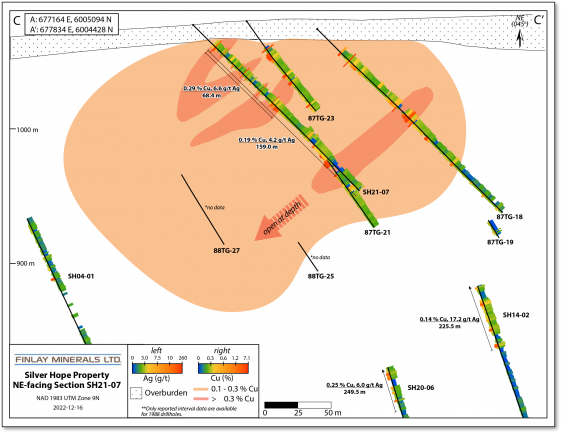
Main Trend Superstition Zone Section D-D